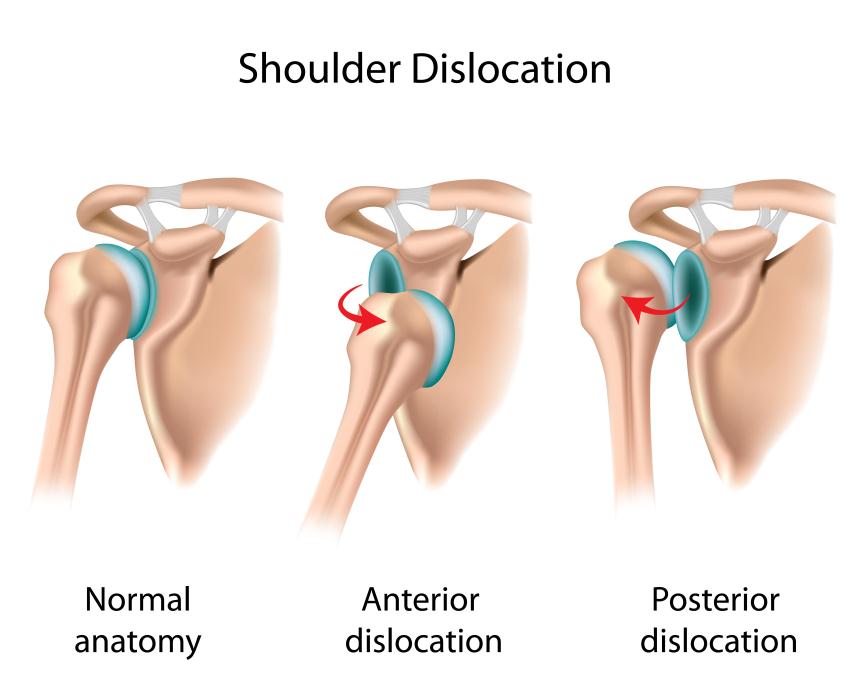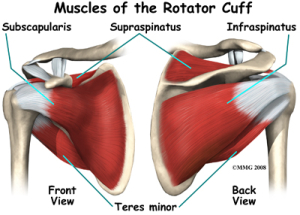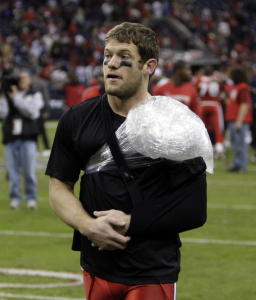The rehabilitation procedures for a dislocated shoulder include: increasing the range of movement/motion, graduated exercise (stretching, conditioning, and total body fitness), training, and the use of heat and cold.
Immediate treatment of a shoulder dislocation
The immediate treatment for a shoulder dislocation is immobilisation of the shoulder and its arm, and to apply ice packs if it does not cause further pain. The athlete is then taken to a professional (medical practitioner, specialist, physiotherapist, etc) who is responsible and trained to put the shoulder back into place (often after an MRI to ensure no nerves or blood vessels are destroyed during the relocation process). After relocation a sling is usually worn for 5-7 days. If the athlete requires surgery then this should also be done before rehabilitation begins. For more information on the treatment of dislocations see the page on dislocation.
Range of motion/movement Stretching
After a dislocated shoulder injury rehabilitation procedures will begin by increasing the range of motion at the shoulder. Often the shoulder is stiff and tight after the sling being worn and the arm being immobilised for so long. Range of motion exercises include a range of stretches that are isometric, PNF and dynamic.
Conditioning
Rehabilitation procedures following a dislocated shoulder will include strengthening the rotator cuff muscles as soon as it is possible (pain free). The rotator cuff muscles are used to stabilise the shoulder joint and are often damaged and weakened following a dislocation. At the beginning of rehabilitation exercises for a dislocated shoulder abduction and lateral rotation of the shoulder are avoided as these are more likely to re-injur the shoulder.
Strengthening exercises begin with isometric contractions. Actions such as: extension, adduction, external and internal rotations and abduction when possible, are all done as isometric contractions. Internal and external rotations particularly target the rotator cuff muscles, strengthening the stability of the shoulder joint.
Movements are then added to the strengthening routine as the shoulder progresses. The first movements are usually external and internal rotation exercises. These then progress to flexion, abduction and extension to strengthen the shoulder. Exercises such as a shoulder press come at the end of the strengthening rehabilitation procedure for a dislocated shoulder.
Once the shoulder is strong, and more importantly stable, general conditioning exercises may be added. Light rowing on a machine may begin, and then progress to arm ergometry. Activities such as swimming are not used until the end, after the athlete has complete range of motion that is pain free and the shoulder has regained strength and stability.
Total Body Fitness
The rehabilitation procedures for a dislocated shoulder take time and result in reversibility occurring in the body. Athletes will need to resume training as soon as possible. During rehabilitation a stationary bike could be used to help maintain some levels of total body fitness. However, running should be avoided during the early stages of rehabilitation because of the jolting through the body and the usual swinging of the arms.
As pain permits, the athlete will begin to engage in other activities such as jogging, running, or cross-training to develop total body fitness. After rehabilitation has been completed the athlete can resume normal training.
Training
Training specific to the sport is always at the end of rehabilitation procedures, and a shoulder dislocation is no different. Coaches will often want their athlete returning from a shoulder dislocation to engage in normal training before they return to play. Athletes need to get their timing back as well as develop their confidence and skills specific to their sport. This is particularly going to be the case if the sport involves tackling, such as: rugby league, rugby union, or AFL.
Use of heat and cold
Cold therapy is used throughout the rehabilitation procedures for a dislocated shoulder. Cold is often used in the acute phase of the injury, which includes the relocation of the shoulder, and after surgery if needed. Cold may also be used after rehabilitation exercises to help reduce the inflammatory response.
Heat may be used initially to help warm up the shoulder before stretching exercises or the initial isometric and dynamic strengthening activities. This is to promote elasticity around the shoulder, and increase blood flow before exercises begin.
Further reading on the rehabilitation procedures for a dislocated shoulder
http://physicaltherapy.about.com/od/sportsinjuries/a/Shoulder-Dislocation.htm
http://physicaltherapy.about.com/od/strengtheningexercises/ss/Shoulder-Active-Range-Of-Motion-Exercises.htm#step3
http://www.sportsinjuryclinic.net/sport-injuries/shoulder-pain/dislocated-shoulder
http://www.sportsinjuryclinic.net/sport-injuries/shoulder-pain/dislocated-shoulder/strengthening-shoulder-dislocation

